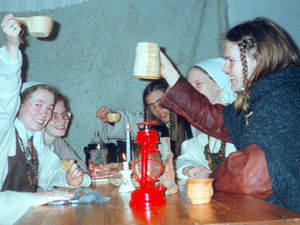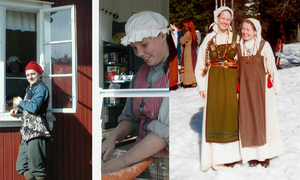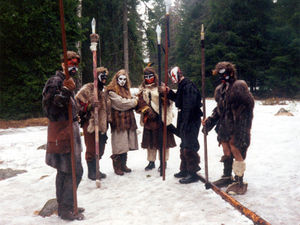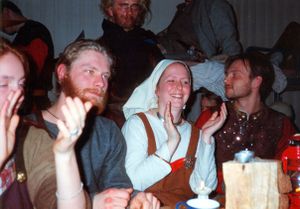Oslo Winterlarps
Oslo Winterlarps was a concept of quasihistoric larps that would involve reliving the daily life of a certain historic period as central aspect of the frame of the larp.
The plotline was often partly mythological marking them as a transitional genrè between the realism of 1942 and Europa and the fantasyfiction of the Oslo Summerlarps of the organisation Ravn and the Nosferatu larps.
Number of participants would range from 50 up to 100 participants.
The average playing time of such larps would be 3 days and 4 nights.
From 1992 to 2002 these would be almost yearly larpevents for the larpers of Oslo.
Contents
Impact
Early concepts, techniques and perceptions of playingstyles in Norway is deeply rooted from the everyday situations that arise when playing non-stop for days in a forest, living in cabins heated with firewood, making and taking food together as a large family, tribe, clan or ætt.
Pertaining to genderissues in the playergroup, the winterlarps moved the action away from running in the woods into classic home and family situations of negotiating between groups about marriages, resources or religion. Girls were often more clever and conspicious than the young male participants in improvising and driving the interaction between the characters in such situations. These games were a crucial factor for the relative genderbalanced participantgroups of Oslo, and also recruited a majority of the first female organisers of Norway.
Ultimately the traditions among both organisers and participants of the Winterlarps in Oslo made the foundations for iconic larps like the 2nd World War game 1942 to be possible. This is also the case for the westerngames Wanted and Once upon a time.
1942 and Once upon a time are included in the Nordic Larp Book.
Playing style
Being 360 degrees larps these concepts avoided off-game time by for example making it a part of the game to also be in character when in your underwear requiring people to provide seemingly period underwear, nightcaps and the like. Non-diegetic items not belonging to the characters environment was banned from the location. This would include watches, flashlights, cameras, walk-mans and after some years beepers and cellphones.
Participant would be in character also when sleeping, when eating, when visiting toilets. This made almost every location an active part of the game. People were at least trying to be in characer when in the toilets, in their sleeping quarters and so forth. Since the cabins would be relativily crowded with people it was viewed as limiting to the game that any indoor location should not be a part of the diegesis. It might not have been a conscious choice of the organisers, but the relatively young playergroup would get so agitated anyway, that it was at this moment in time difficult to upheld a rule of not allowing participants to sneak around other people sleeping, or kidnap people when they went to the traditional outdoor toilets in the dark.
(See the building in this photo to imagine a typical outdoor toilet and gaming location nighttime at these larps: http://www.maion.com/media/b2c56340-3668-11df-9d3e-19590d98061b-outdoor-toilets)
Plotlines
Mythological and religious elements would in the early years still be 30-50% of the plotelements available for the characters to explore. Characters would be normal people in an historic age, and their beliefs and superstitions would come to life through different technology and techniques in use by the organisers while the game unfolded. Special charactergroups would have special makeup or costumes to enhance the belief of something supernatural, but in the end, they were most often based on secular explanations. The mysterious Elf in the forest was in the end the mentally retarded child of the parents, that they tried to hide away. The Faeryfolk would be Pictish Tribes from the Scottish highlands interfering with the rest of the Celtic community.
The difference between summerlarps and winterlarps would be that the vast majority of players would not have access to any magical or supernatural powers. There might be characters like druid or a norse volve would be present, but the supernatural would be in the hands of the organisers in forms of soundeffects, pyrotechnics like smokemachines, and especially in the form of staged visits of supernatural creatures dressed up and instructed by the organisers.
Over the years the pyrotechnics got less important and the relationshipwebs between the players took focus. The overall plotlines moved from organiserdriven, to organiser fasciliated, to playerdriven and even player initiated.
Techniques
- Scheduling
- Story Arcs
- Recurring scenes (also known as daily routines)
- Ceremonies
- Meetings
- Rituals
- Hierarchies
- Groupplay
- Groupconflicts
- Prewritten characters
- NPCs - (Non Player Characters)
- Relationshipwebs
- Retrospective storylines (Ibsen style, dark secrets from the past is reveiled in the present.)
- Secrecy
- Staging
- Flying Start
- Branching incentivewebs (also at this point in time called "plots" in the Osloscene.)
- Dreamrooms (Early variant of a Black Box or Meta-room)
- Dreaming (Early variant of a Meta-technique)
- Bofferweapons
- Pyrotechnics
- Non-Diegetic Sound
- Players Companion Booklet
- Local Community Description
- SL
- FX
- IL(Personally CharacterDesigner)
- 360
Preparations
Participants would be divided into familygroups of 10-20 people. Normally the size of the group would match a selected house which would be the base location for this groups play. Participantsfactions would meet regularily up to 6 months prior to the game, to decide on common clothing, plan for food, special customs or other appropriate excercises. In one game the group playing samipeople memorized some 100 words of Sami and used grammar to be totally incomprehensible for the rest of the participants. Skis that would give a period impression were prepared. Old tools were brought to the game. Axes for cutting trees and making firewood. Shovels for digging in the snow.
The evening before the start of the larp participants would decorate their living quarters, get into costumes, make food and be only partly playing their characters. They might do last minute practice of names of related characters. Individually people would be testing the way of talking in-character, and often practice common songs related to the diegesis or the the overall genrè of the larp. More importantly participants would discuss routines like when to wake up, dishwashing, fetching water, maintaining the fire, foodmaking and establish time and reponsibility for common meals and other practical matters. An organiser would oversee this and balance it with the Scheduling and the Storyarc of the larp.
Origin
The reason for these historic larps to be held in wintertime was to be able to provide another form of larps that was suited to do in the off-season period of the winter holidays. In contrast to their predecessors, the fantasybased summerlarps cabins needed to be rented in order to be able to handle the cold weather. The summerlarps use of tents or pineshelters was inadequate due to the temperature and the snow. Cabins where rented through active larpers that had connection with the organisations of the Norwegian Scoutmovement (http://en.wikipedia.org/wiki/Scouting).
Changing the climate and the physical environment from tents and grass, to snow and cabins affected the content and pace of these games.
Many of these larps was played during the Easter Holidays.
Traditionally norwegian families go into the mountains and visit old familyowned cabins or farms during the Easter holidays.
The cabins often have poor sanitation fascilities, no electricity and is heated with firewood.
These are holidays where the family spends a lot of time outdoor during daytime, and gather around a long table to share common meals evening time. Singing and playing cardgames is often also a part of this holiday. The winterlarps can be viewed as the larpers of Oslos mimicking these traditions into their larptradition.
(Wikipedia article on Nordic Easter Traditions: http://en.wikipedia.org/wiki/Easter_customs#Nordic_countries)
Flying Start
- A Winterlarp usually had a typical element of a flying start. Participants would go to bed out of character with the instructions that the larp will start when they wake up. Often the organisers would stage a scene early morning when everybody were asleep that would wake people up and kickstart the story. This would allow the characters a reason to feel alarmed, and also allowing the players excuses within the diegesis for their character to be confused or insecure about how to react believable in character for the first hours of the larp.
List of Games
- 1992 - Vingulmork 1196 - Set to the era of King Sverre who defied the pope
- 1993 - Kelterlaiven (The larp of the Celts) - Settlement of celts and vikings in north of the Brittish Isles haunted by mythological creatures of those cultures myths.
- 1994 - Vikinglaiven (The larp of the vikings) - Set to the era of the ancestor of the ancient kings of Norway, Halfdan Svarte (Halfdan the Black).
- 1995 - Pestlaiven (The larp of the black death) - Based on old norwegian folktraditions and faeries.
- 1996 - Bronsealderlaiven (The larp of the bronzeage)
- 1997 - Et vintereventyr - (A winters fairytale) - First pan-nordic Larp ever, organised parallell to the first Knutepunkt)
- 1998 - no traditional Winterlarp this year, instead 1944 was organised as the first 2nd Wordwar larp (many similarities in playing style)
- 1999 - no Winterlarp this year (it was a year of many other experiments during wintertime, the old crowd went to the 1920ies investigational crimestory larp named Dark Hill Mansion)
- 2000 - Fremmede Drømmer (Alien Dreams) - Based on old norse myths of the book Edda.
- 2002 - Enigheten - (Historic game Wintertime, but set to the time of industrialisation in Norway) (http://folk.uio.no/mraaum/laiv/enighet-008.jpg)
Documentation
Photo here: http://www.laivgalleriet.no/gallery2/v/laiver/ravn/ravn94/album02/vinter_1994_drekka_mer.jpg.html
Tv-report made by the Youthdepartment of the National Broadcasting of Norway (NRK) in 1992 from the first Oslo Winterlarp
Slideshow of photos from The Black Death larp in 1995 -



